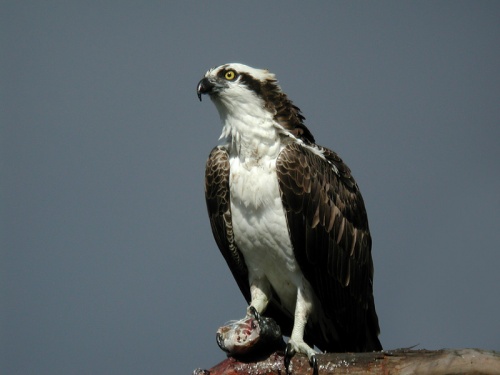- Pandion haliaetus
Identification
Very large raptor, nearly eagle-sized. Wingspan reaches up to 72 inches. Long, slender wings compared to body. Noticeably emarginated primaries at the wing ends, sometimes pulled together, making the wing appear pointed. Soars and glides with a "kink" in its wings. Dark brown above, white with patterning below. Has a rather prominant nape crest. Dark eye-stripe is distinctive and noticeable, giving the bird a masked appearance. Beak is dark, eyes yellow. Talons sharp, with scutes for holding slippery prey.
Male has a cleaner breast with less streaking than on the female. Dark carpal patch, barred tail.
Juveniles have pale edgings to their feathers, give them a scaled appearance. Young birds also sport a buffy breast for a time, and have orange eyes.
Distribution
North, Central and South America, Africa, Eurasia and Australasia. Breeds from western Alaska and across much of non-Arctic Canada, and in the USA over much of the north-west as far as southern California. In the east breeds around the Great Lakes, on the east coast south to Florida and west along the Gulf Coast to Mississippi. Also breeds coastally in Mexico in Baja California, Sonora, Sinaloa and also on the east coast of the Yucatan Peninsula and in adjacent Belize. Elsewhere in the Caribbean breeds in the Bahamas and on Cuba. Birds breeding in Florida, Mexico and the Caribbean are resident but further north this is a summer visitor which winters from Mexico, the West Indies and in South America south to central Chile in the west and Uruguay in the east. The Osprey does not breed in South America. A widepread and common winter visitor to Africa from the Palearctic, most numerous in West Africa but also occurs east to Somalia and south to the Cape. Breeding range in Africa is restricted the Mediterranean coast of Morocco and western Algeria and the Red Sea and has bred on rare occasions in southern Africa. However, it does breed on the Canary Islands and Cape Verde Islands in the Atlantic. A widespread summer visitor to much of Scandinavia and Russia, Belarus and Ukraine. Smaller isolated pockets of range in Scotland, Germany, Poland and the Baltic States. There are also small resident populations further south on the Atlantic coast of southern Portugal, on the Mediterranean coast of Spain, the Balearics and on Corsica. Increasing in Scotland since its recolonisation in the 1950s and now breeding in the south, and the first breeding in England for centuries has taken place. One pair bred in Cumbria in 2001 and a reintroduction scheme using birds translocated from Scotland led to successful breeding at Rutland Water. Also in 2002 nest-building occurred for the first time in the Netherlands.
Occurs as a widespread migrant throughout Europe with peak passage periods in April-May and August-September. Migrants do not concentrate at particular sites to cross seas as many other raptors do. Most winter in sub-Saharan Africa but some in the western Mediterranean, in particular on Sardinia, Sicily and North-West Africa, also at the head of the Red Sea and in southern Iraq. Vagrants recorded north to Ireland, Iceland and Faroes, also on the Azores and Madeira. A widespread breeder across northern Asia from the Urals east to Kamchatka, Sakhlain and Japan. Also breeds in the Middle East mainly on islands in the Red Sea and Persian Gulf. Northern birds also winter in these areas and in India and South-East Asian from southern China, Taiwan, Hainan and the Philippines south to Sumatra and Borneo. Australasian breeders are resident and occur from Sulawesi and the Lesser Sundas to New Guinea, the Bismarck Archipelago, Solomon Islands and New Caledonia. In Australia breeds on much of the western and northern coasts and in the east on the coral islands of the Great Barrier Reef. Now rare on the south coast but still breeds in the Spencer Gulf and Adelaide areas.
Taxonomy
Four - six subspecies are recognised. Nominate race breeds in the Palearctic, carolinensis with paler breast-band in North America, ridgwayi in the Caribbean with whiter head and breast; and the smaller cristatus from Australasia. Birds from the Philippines to northern Australia are sometimes separated as melvillensis and those from New Caledonia as microhaliaetus but these races are not universally recognised.
Habitat
Closely tied to water at all seasons. In the north nests in trees close to medium-large freshwater lakes. In Mexico, the Mediterranean, Middle East and elsewhere nests on rocky islets and cliffs and hunts over the sea. Nests on the ground on some Red Sea islands. Strictly coastal in many areas although will follow large rivers inland in Australia. On passage frequently seen at reservoirs, fish-ponds and estuaries, along sea-coasts and larger rivers.
Behaviour
Comments
There has up to now been one breeding pair in Cumbria. The same pair each year. No ring and XS. However there are plenty of 'spare' ospreys hanging around so there is hope this may increase. Originally posted by Osprey_watcher
This year (2007) the original female did not return and a new female with no rings has successfully bred with the male and they now have 3 chicks. You can access the webcam and information on the Bassenthwaite Opsreys here: [1]
Bird Song
<flashmp3>Pandion haliaetus (song).mp3</flashmp3>
Listen in an external program




